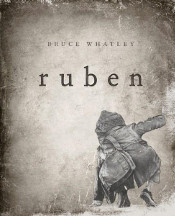Ruben by Bruce Whatley

Scholastic, 2017. ISBN 9781743810354
(Age: 7 to adult) Highly recommended. Picture book for older
readers, Homelessness, Cities, Survival. A child emerges from his
safe place. He must venture out into the abandoned factories and
buildings around Block City to find food. He watches the huge
overloaded trains that come into the city, delivering their goods,
returning empty. Nothing is available to him, the goods vans all
locked. He must be careful wandering around this place avoiding the
robotic watchers on the prowl for people who should not be there.
So Whatley develops his bleak and scary background, a few spare
words being but a small part of the evocative story, the
illustrations detailing a city dying at the edges, living only for
itself, oblivious to the plight of the street people, the homeless,
those surviving on the edge. Every page of the three sections is
full of meticulously drawn detail, detail that will astonish the
reader, at once absorbed by the city and its structures, but also
grieving for the lone child who lives in its shadows.
Children will soak up the atmosphere Whatley creates through his
pencil drawings, using just light and shade, a wonderful exposition
of entwined factories, industrial detritus and abandoned warehouses,
above ground train lines, derelict buildings, metalwork and
plumbing. I was enthralled looking at the detail offered on each
page as will younger readers pointing out detail and found objects
to each other as they read and follow Ruben's story.
The 100 or so pages zip by as the readers are drawn into Ruben's
tale, their hearts with him as he avoids the huge wheels of the
train, runs from the Listeners, the Controllers and the Sweepers and
strives to find something useful in an increasingly sparse and
hostile environment.
As he goes further into the city he sees someone else in the shadows
and makes a small boat which slides down the puddle to her.
He picks up a book dropped from one of the carriages, and in the
Epilogue their stories come together.
Whatley began this story ten years ago and began the illustrations
six years ago. This engrossing finished product will create much
discussion and debate within the classroom, from talk about being
homeless in our society to dystopian fiction and its implications,
impelling us to rethink the environment in which we live. But
reflection ensures the reality of Whatley's book hits home, it is
not a future but a now that we are looking at. His book makes us
profoundly aware of the dramatically changing industrial landscape
leaving so many of our population bereft. It is a salutary read.
Fran Knight